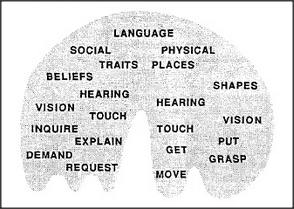


Our polynemes and micronemes grow into great branching networks that reach every level of every agency. They approximate the general form of a hierarchy, but one that is riddled with shortcuts, cross- connections, and exceptions. No one could ever comprehend all the details of the connections that develop inside a single human individual; that would amount to grasping how all that person's thoughts and inclinations interact. At best, we can envision only the broadest outlines of such structures:

In regions near the agencies for speech, some elements of this network might signify or represent ideas and thoughts we can easily express in words. But because speaking is a social act, we are far less able to express the significance of the nemes involved with agencies that are not directly concerned with communication. This is because those agencies are less constrained by the discipline of public language; accordingly, the nemes inside those agencies can vary more from one person to the next.
In any case, our higher-level agencies are generally unaware of what our lower-level agents do; they supervise and regulate — but scarcely comprehend at all — what happens among their subordinates. For example, a high-level agency might find that a certain subagency is unproductive, because it is responding to too many micronemes — or to too few — and adjust its sensitivity accordingly. Like a B-brain, a controlling agency could make such judgments without comprehending the local meanings of those micronemes. This could also provide a basis for controlling the levels of the activities of those other agencies — just as we suggested when we discussed the idea of a spiral computation within an agency and its K-line trees. When the work appears to be going well, the supervisor can direct the lower-level processes to spiral down toward small details. But when there seem to be too many obstacles, the level of activity would be made to spiral up instead, to levels capable of diagnosing and altering an ineffective plan.